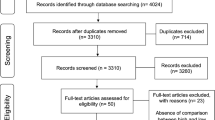Abstract
This paper presents a systematic review of the literature concerning fluoride that was carried out to investigate whether fluoride exposure increases the risk of low intelligence quotient (IQ) in China over the past 20 years. MEDLINE, SCI, and CNKI search were organized for all documents published, in English and Chinese, between 1988 and 2008 using the following keywords: fluorosis, fluoride, intelligence, and IQ. Further search was undertaken in the website www.fluorideresearch.org because this is a professional website concerning research on fluoride. Sixteen case–control studies that assessed the development of low IQ in children who had been exposed to fluoride earlier in their life were included in this review. A qualitative review of the studies found a consistent and strong association between the exposure to fluoride and low IQ. The meta-analyses of the case–control studies estimated that the odds ratio of IQ in endemic fluoride areas compared with nonfluoride areas or slight fluoride areas. The summarized weighted mean difference is −4.97 (95%confidence interval [CI] = −5.58 to −4.36; p < 0.01) using a fixed-effect model and −5.03 (95%CI = −6.51 to 3.55; p < 0.01) using a random-effect model, which means that children who live in a fluorosis area have five times higher odds of developing low IQ than those who live in a nonfluorosis area or a slight fluorosis area.
Similar content being viewed by others
Avoid common mistakes on your manuscript.
Introduction
The association between low intelligence quotient (IQ) scores in children and high level of fluoride in drinking water has been reported [1]. However, how strong the association is is unknown. In China, endemic fluoride poisoning is serious, and there are thousands of people and children live in endemic fluorosis areas. The objective of this paper is to present a meta-analysis to answer the following question: Is there truly an association between low IQ and fluoride in total 20 years? How strong is the association?
To assess the strength of the association between the level of fluoride in water and IQ, weighted mean difference (WMD) is used. The magnitude of WMD determines the strength of an association between fluoride levels and low IQ. In a meta-analysis, a systematic review of the literature is conducted, and studies are included or excluded from the analysis depending on whether they meet the eligibility criteria for inclusion set by the reviewers. The data are combined statistically to provide a quantitative estimate of the size of effect of exposure and risk of disease [2].
Materials and Methods
Literature Search
MEDLINE, SCI, and CNKI search were organized for all studies published, in English and Chinese, between 1988 and 2008. The following keywords were used to search for all documents: fluorosis, fluoride, intelligence, or IQ. A further search was undertaken in the website www.fluorideresearch.org because this is a professional website concerning research on fluoride. The country was restricted to China. As a result, 18 case–control studies were located with enough data to allow for further quantitative analysis (Table 1).
A total of 26 studies were excluded. Some excluded studies did not present enough data to allow inclusion in the meta-analysis. Another reason for exclusion was some of the papers had been included, which means that they had been published more than one time or had been published in two journals in Chinese or English language.
Meta-analysis
The analysis included 16 case–control studies. The summary WMD and 95% confidence intervals (CI) were obtained using the following two statistical methods (Table 2):
-
1)
Mantel–Haenszel method: estimates the summary WMD and its standard error
-
2)
DerSimonian–Laird method: estimates the summary WMD and its standard error. No test of homogeneity is available for this method
The Mantel–Haenszel should be used in a fixed-effect model, while the DerSimonian–Laird methods should be used in a random-effect model. Tests of homogeneity of variances for the Mantel–Haenszel were performed as described by Petitti [2].
Sensitivity Analysis
Sensitivity analysis was used to assess how robust the results are to uncertain decisions or assumption about the data and the methods that were used [3] (Table 3).
Results
Case–Control Studies
These studies are listed in chronological order in Table 1. Children expose to fluoride had a significant increase in the risk of developing low IQ. Twelve studies found statistically positive associations between the exposure to fluoride and low IQ (Table 1). The risk of developing low IQ ranged from a low of 0.2 to a high of 10.78 [1, 4–18].
Meta-analysis
The Mantel–Haenszel method estimated that the summary WMD for the association between exposure to fluoride and low IQ is about −4.97 (95% CI = −5.58 to −4.36; p < 0.01). The DerSimonian–Laird gave a summary WMD of −5.03 (−6.51 to −3.55; p < 0.01; Table 2). Because of the lack of homogeneity of variances among the studies, the results of the Mantel–Haenszel method may be invalid. The random-effect method that is the basis for the DerSimonian–Laird algorithm is preferred in this case. Overall, the meta-analyses found that the summary WMD on average is about 5, indicating that children who live in a fluorosis area have five times higher odds of developing low IQ than those who live in a nonfluorosis area or a slight fluorosis area.
Sensitivity Analysis
To analyze the sensitivity of our study, two studies were excluded because the samples of the two studies were large and thus may increase the heterogeneity: Li’s paper, the samples of which were 720 for the fluorosis area and 236 for the control, and Chen’s paper, the samples of which were both 320 for the fluorosis area and the control (Table 3). The results of the sensitivity analysis show that with either Li’s or Chen’s study excluded, the summary WMD and 95% CI were still near to the results before they were excluded. Further, when the two studies were excluded at the same time, the results were also stable. Hence, the results of the sensitivity analysis indicate that the results of our study are reliable and believable.
Funnel Plot for Bias Analysis
Figure 1 is the funnel plot of our study, which shows the bias of our study. From the figure, we can see that there are biases in our study. Publication bias and language bias may be the main causes.
Discussion
The mechanism of the action of fluoride in reducing IQ is not clear. Guan et al. [19] demonstrated that the contents of phospholipids and ubiquinone are altered in the brain of rats affected by chronic fluorosis, and therefore changes in membrane lipids could be a cause of this disorder. Furthermore, thyroid hormones play an important role in development of brain and thus might also affect IQ level [20]. However, the strength between fluoride and low IQ is still unknown.
We investigated this study to summarize the 20-year studies concerning the association between fluoride and low IQ in China and to try to find if there is truly an association between them in total 20 years and how strong the association is. Our findings show that children who live in a fluorosis area have five times higher odds of developing low IQ than those who live in a nonfluorosis area or a slight fluorosis area. Hence, further action should be undertaken to reduce the fluoride level in the water of a fluorosis area, which is also urgent and necessary.
References
Xiang Q, Liang Y, Chen L et al (2003) Effect of fluoride in drinking water on children’s intelligence. Fluoride 36:84–94
Petitti DB (1994) Meta-analysis, decision analysis and cost-effectiveness analysis. Methods for quantitative synthesis in medicine. Oxford University Press, New York, pp 90–123
Breierova L, Choudhari M (1996) An introduction to sensitivity analysis. MIT, Cambridge, MA, pp 41–107
An JA, Mei SZ, Liu AP et al (1992) Effect of high level of fluoride on children’s intelligence. Zhong Guo Di Fang Bing Fang Zhi Za Zhi 7(2):93–94 (in Chinese)
Xu YL, Lu CS, Zhang XN (1994) Effect of fluoride on children’s intelligence. Di Fang Bing Tong Bao 9:83–84 (in Chinese)
Li XS, Zhi JL, Gao RO (1995) Effect of fluoride exposure on intelligence in children. Fluoride 28(4):189–192
Zhao LB, Liang GH, Zhang DN et al (1996) Effect of a high fluoride water supply on children’s intelligence. Fluoride 29(4):190–192
Wang GJ, Yang DL, Jia FG et al (1996) Research of intelligence quotient of 4–7 years old children in district with high level of fluoride. Di Fang Bing Tong Bao 11(1):60–62 (in Chinese)
Yao LM, Deng Y, Yang SY et al (1997) Comparison of children’s health and intelligence between the fluorosis area with altering water source and those without altering water source. Yu Fang Yi Xue Wen Xian Xin Xi 3(1):42–43 (in Chinese)
Zhang JW, Yao H, Chen Y (1998) Effect of high level of fluoride and arsenium on children’s intelligence. Zhong Guo Gong Gong Wei Sheng Xue Bao 17(2):119 (in Chinese)
Lu Y, Sun ZR, Wu LN et al (2000) Effect of high-fluoride water on intelligence in children. Fluoride 33(2):74–78
Wang SX, Wang ZH, Cheng XT et al (2005) Investigation and evaluation on intelligence and growth of children in endemic fluorosis and arsenium areas. Zhong Guo Di Fang Bing Xue Za Zhi 24(2):179–182 (in Chinese)
Fan ZX, Dai HX, Bai AM et al (2007) Effect of high fluoride exposure on children intelligence. Huan Jing Yu Jian Kang Za Zhi 24(10):802–803 (in Chinese)
Wang SX, Wang ZH, Cheng XT et al (2007) Arsenic and fluoride exposure in drinking water: children’s IQ and growth in Shanyin county, Shanxi province, China. Environ Health Perspect 115(4):643–647
Chen YX, Han FL, Zhou ZL et al (2008) Research on the intellectual development of children in high fluoride areas. Fluoride 41(2):120–124
Guo XC, Wang RY, Chen CF et al (2008) A preliminary investigation of the IQs of 7–13 year-old children from an area with coal burning-related fluoride poisoning. Fluoride 41(2):125–128
Hong FG, Cao YX, Yang D et al (2008) Research on the effects of fluoride on child intellectual development under different environmental conditions. Fluoride 41(2):156–160
Li YP, Jing XY, Chen D et al (2008) Effects of endemic fluoride poisoning on the intellectual development of children in Baotou. Fluoride 41(2):161–164
Guan ZZ, Wang YN, Xiao KQ et al (1999) Influence of chronic fluorosis on membrane lipids in rat brain. Neurotoxicol Teratol 20:537–542
Trivedi MH, Verma RJ, Chinoy NJ et al (2007) Effect of high fluoride water on intelligence of school children in India. Fluoride 40:178–183
Acknowledgment
The authors are grateful to Dr. Gui-lan Tang, College of Resources and Environmental Sciences, China Agricultural University, Beijing, People’s Republic of China, for providing the critical review and assistance during the course of this investigation. The authors also appreciate the editor board and the reviewers for their work on this paper.
Author information
Authors and Affiliations
Corresponding author
Rights and permissions
About this article
Cite this article
Tang, Qq., Du, J., Ma, Hh. et al. Fluoride and Children’s Intelligence: A Meta-analysis. Biol Trace Elem Res 126, 115–120 (2008). https://doi.org/10.1007/s12011-008-8204-x
Received:
Accepted:
Published:
Issue Date:
DOI: https://doi.org/10.1007/s12011-008-8204-x





